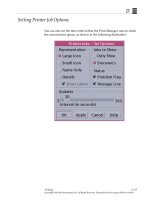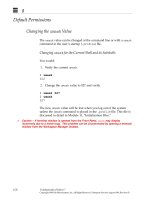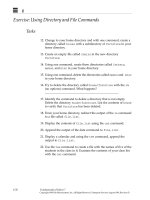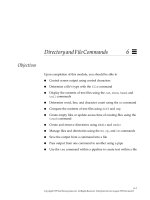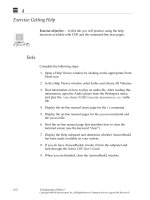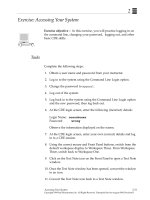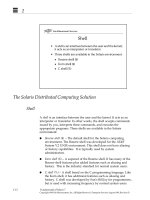Student Guide - Oracle® GoldenGate Fundamentals
Bạn đang xem bản rút gọn của tài liệu. Xem và tải ngay bản đầy đủ của tài liệu tại đây (2.41 MB, 245 trang )
Oracle® GoldenGate
Fundamentals
Student Guide
Version 10.4
October 2009
Oracle GoldenGate Fundamentals Student Guide, version 10.4
Copyright © 1995, 2009 Oracle and/or its affiliates. All rights reserved.
This software and related documentation are provided under a license agreement containing restrictions on use and
disclosure and are protected by intellectual property laws. Except as expressly permitted in your license agreement
or allowed by law, you may not use, copy, reproduce, translate, broadcast, modify, license, transmit, distribute,
exhibit, perform, publish, or display any part, in any form, or by any means. Reverse engineering, disassembly, or
decompilation of this software, unless required by law for interoperability, is prohibited.
The information contained herein is subject to change without notice and is not warranted to be error-free. If you
find any errors, please report them to us in writing.
If this software or related documentation is delivered to the U.S. Government or anyone licensing it on behalf of the
U.S. Government, the following notice is applicable:
U.S. GOVERNMENT RIGHTS Programs, software, databases, and related documentation and technical data
delivered to U.S. Government customers are "commercial computer software" or "commercial technical data"
pursuant to the applicable Federal Acquisition Regulation and agency-specific supplemental regulations. As such,
the use, duplication, disclosure, modification, and adaptation shall be subject to the restrictions and license terms
set forth in the applicable Government contract, and, to the extent applicable by the terms of the Government
contract, the additional rights set forth in FAR 52.227-19, Commercial Computer Software License (December 2007).
Oracle USA, Inc., 500 Oracle Parkway, Redwood City, CA 94065.
This software is developed for general use in a variety of information management applications. It is not developed
or intended for use in any inherently dangerous applications, including applications which may create a risk of
personal injury. If you use this software in dangerous applications, then you shall be responsible to take all
appropriate fail-safe, backup, redundancy, and other measures to ensure the safe use of this software. Oracle
Corporation and its affiliates disclaim any liability for any damages caused by use of this software in dangerous
applications.
Oracle is a registered trademark of Oracle Corporation and/or its affiliates. Other names may be trademarks of their
respective owners.
This software and documentation may provide access to or information on content, products, and services from third
parties. Oracle Corporation and its affiliates are not responsible for and expressly disclaim all warranties of any
kind with respect to third-party content, products, and services. Oracle Corporation and its affiliates will not be
responsible for any loss, costs, or damages incurred due to your access to or use of third-party content, products, or
services.
Contents
ABOUT GOLDENGATE – COMPANY AND SOLUTIONS.................................................................. 5
TECHNOLOGY OVERVIEW ................................................................................................................. 18
ARCHITECTURE ..................................................................................................................................... 22
CONFIGURING ORACLE GOLDENGATE ......................................................................................... 28
STEP 1. PREPARE THE ENVIRONMENT ....................................................................................................... 29
GOLDENGATE COMMAND INTERFACE...................................................................................................... 46
STEP 2. CHANGE CAPTURE ....................................................................................................................... 51
STEP 3. INITIAL LOAD ............................................................................................................................... 64
STEP 4. CHANGE DELIVERY ...................................................................................................................... 71
EXTRACT TRAILS AND FILES............................................................................................................. 76
GOLDENGATE DATA FORMAT .................................................................................................................. 79
ALTERNATIVE FORMATS .......................................................................................................................... 85
VIEWING IN LOGDUMP ............................................................................................................................. 92
REVERSING THE TRAIL SEQUENCE ......................................................................................................... 104
PARAMETERS ........................................................................................................................................ 107
GLOBALS PARAMETERS....................................................................................................................... 109
MANAGER PARAMETERS ........................................................................................................................ 110
EXTRACT PARAMETERS .......................................................................................................................... 113
REPLICAT PARAMETERS ......................................................................................................................... 122
DATA MAPPING AND TRANSFORMATION ................................................................................... 131
DATA SELECTION AND FILTERING .......................................................................................................... 131
COLUMN MAPPING ................................................................................................................................. 138
FUNCTIONS ............................................................................................................................................. 141
SQLEXEC ............................................................................................................................................. 149
MACROS ................................................................................................................................................. 158
USER TOKENS......................................................................................................................................... 163
USER EXITS ............................................................................................................................................ 170
ORACLE SEQUENCES .............................................................................................................................. 177
CONFIGURATION OPTIONS .............................................................................................................. 178
BATCHSQL .......................................................................................................................................... 179
COMPRESSION ........................................................................................................................................ 182
ENCRYPTION .......................................................................................................................................... 183
EVENT ACTIONS ..................................................................................................................................... 187
BIDIRECTIONAL CONSIDERATIONS ......................................................................................................... 192
ORACLE DDL REPLICATION ................................................................................................................... 202
MANAGING ORACLE GOLDENGATE ............................................................................................. 211
COMMAND LEVEL SECURITY ................................................................................................................. 211
TRAIL MANAGEMENT ............................................................................................................................. 214
PROCESS STARTUP AND TCP/IP ERRORS ............................................................................................... 219
REPORTING AND STATISTICS .................................................................................................................. 221
MONITIORING ORACLE GOLDENGATE ................................................................................................... 229
TROUBLESHOOTING ................................................................................................................................ 235
TECHNICAL SUPPORT ............................................................................................................................. 244
Oracle GoldenGate Fundamentals Student Guide
About GoldenGate – Company and Solutions
Our Business
We enable real-time, continuous movement of transactional data across
Operational and Analytical business systems.
Real-Time Access
to
Real-Time Information
Real-Time Information
Real-Time Access
Availability: the degree to
which information can be
instantly accessed.
Mission-Critical
Systems
Integration: the process of
combining data from different
sources to provide a unified view.
Oracle GoldenGate provides solutions that enable your mission-critical systems to
have continuous availability and access to real-time data.
We offer a robust yet easy platform for moving real-time transactional data between
operational and analytical systems to enable both:
- High Availability solutions, and
- Real Time Integration solutions
• Real-Time Access -- meaning your critical data is accessible and available
whenever you need it, 24x7.
At the same time…
• Real-Time Information -- meaning that the data available is as current as
possible – not 24 hours old, not even 4 hours old.
Oracle GoldenGate Success
Company Strength
and Service
GoldenGate Software
established in 1995
Acquired by
Oracle in 2009
Global sales and
support
Rapid Growth in
Strategic Partners
500+ customers... 4000+ solutions implemented… in 35 countries
Established, Loyal
Customer Base
Our partnerships are rapidly increasing with major technology players, including
database and IT infrastructure, packaged applications, business intelligence, and
service providers.
And because our software platform supports a variety of solution use cases… Our
more than 500 customers are using our technology for over 4000 solutions around the
world. What we typically find that once an initial solution is implemented and the
benefits achieved, our customers then find additional areas across the enterprise
where we can further drive advantages for them.
Oracle GoldenGate Fundamentals Student Guide
Transactional Data Management (TDM)
Oracle GoldenGate provides low-impact capture, routing, transformation, and
delivery of database transactions across heterogeneous environments in real
time
Additional Differentiators:
Key Capabilities:
Real Time
Moves with sub-second latency
Heterogeneous
Moves changed data across
different databases and platforms
Transactional
Performance
Log-based capture moves
thousands of transactions
per second with low
impact
Extensibility &
Flexibility
Meets variety of customer
needs and data
environments with open,
modular architecture
Reliability
Maintains transaction integrity
Resilient against
interruptions and failures
Our focus is on transactional data management (TDM) – which means delivering a
platform in which that data can be best utilized in real-time enterprise wide.
Oracle GoldenGate captures, routes, transforms, and delivers transactional data in
real time – and it works across heterogeneous environments with very low impact and
preserved transaction integrity.
Our Key Capabilities in which we architect the product are:
• We move data essentially in “real time” – with sub-second speed.
• Works in heterogeneous environments – across different database and
hardware types
• Transactional – we are “transaction aware” and apply read-consistent
changed data to maintain its referential integrity between source and target
systems.
We further Differentiate ourselves from other technologies with:
- High performance with low impact – we can move large volumes of data
very efficiently while maintaining very low lag times/latency.
- Our flexibility – we meet a wide range of customer solution and integration
needs, thanks to our open, modular architecture.
- Our reliability – our architecture is extremely resilient against potential
interruptions; no single point of failure or dependencies, and easy to recover.
7
TRANSACTIONAL
DATA INTEGRATION
Oracle GoldenGate provides the following data replication solutions:
•High Availability
Live Standby for an immediate fail-over solution that can later re-synchronize with
your primary source.
Active-Active solutions for continuous availability and transaction load distribution
between two or more active systems.
•Zero-Downtime Upgrades and Migrations
Eliminate downtime for upgrades and migrations.
•Live Reporting
Feeding a reporting database so that you don’t burden your source production
systems.
•Operational Business Intelligence (BI)
Real-time data feeds to operational data stores or data warehouses, directly or via
ETL tools.
•Transactional data integration
Real-time data feeds to messaging systems for business activity monitoring (BAM),
business process monitoring (BPM) and complex event processing (CEP).
Uses event-driven architecture (EDA) and service-oriented architecture (SOA).
Oracle GoldenGate Fundamentals Student Guide
Oracle GoldenGate Solutions
High Availability & Disaster
Tolerance
Real-Time Data Integration
Live Standby
Real-Time Data Warehousing
Active-Active
Live Reporting
Zero-Downtime Operations for:
Transactional Data Integration
Upgrades
Migrations
Maintenance
Oracle GoldenGate provides two primary solution areas:
High Availability/Disaster Tolerance and Real-Time Data Integration.
Within High Availability and Disaster Tolerance, we offer:
• Active-Active solutions for continuous availability and transaction load distribution
between two or more active systems
•Zero-Downtime Operations that eliminates downtime for planned outages involving
upgrades, migrations, and ongoing maintenance
•Live Standby for an immediate fail-over solution that can later re-synchronize with
your primary source
Within Real-Time Data Integration, we offer:
• Real-Time Data Warehousing which gives you real-time data feeds to data
warehouses or operational data stores
•Transactional Data Integration for distributing data in real-time between
transaction processing systems
•Live Reporting is for feeding a reporting database so that you don’t burden your
source production systems
9
Oracle GoldenGate for High Availability & Disaster Tolerance
High Availability & Disaster
Tolerance
Live Standby
Active-Active
Zero-Downtime Operations for:
Upgrades
Migrations
Maintenance
Real-Time Access
Improved Uptime
Higher Performance
Faster Recovery
Minimized Data Loss
Lower TCO
For High Availability and Disaster Tolerance solutions, it’s about “real-time” or
CONTINUOUS access to your data via your critical applications.
The benefits that Oracle GoldenGate drives here include:
-Improved uptime and availability (helping you reach aggressive service level
agreements/SLAs)
-Higher Performance for your production systems – help to eliminate scalability or
response time delays that can give users the impression of an availability or access
issue
-Faster Recovery and Minimized Data Loss – so you can achieve higher Recovery
Time Objectives (RTOs) and Recovery Point Objectives (RPOs)
- and an overall lower Total Cost of Ownership by putting your standby systems to
work for other solutions!
Oracle GoldenGate Fundamentals Student Guide
High Availability: Live Standby
Benefits:
Eliminate unplanned downtime
Reduce data loss and isolate corrupt data
Re-synchronize backup and primary systems
Remove distance constraints
Automate switchovers
Improve ROI with active standby available for reporting
Live Standby: helps eliminate unplanned outages to enable continuous availability,
with no geographic distance constraints.
Oracle GoldenGate moves changed data from primary database to a standby in subseconds so that end users have a reliable failover system with up to date data that
they can immediately switchover.
There is no database recovery process required because changed data is queued
outside of the database in persisted Trail files, and data loss risk is minimized. Oracle
GoldenGate also isolates corrupt data during movement to make sure the secondary
system is reliable when it is needed.
The customer’s Return on Investment can be further increased by using the live
standby system for reporting or testing – Oracle GoldenGate allows the standby
database to be open, so it does not have to sit idle and can be put to work!
11
High Availability: Active-Active
Benefits:
Achieve continuous availability
Enable transaction load distribution (with built-in conflict resolution)
Improve performance
Lower TCO
Active-Active: Oracle GoldenGate enables bidirectional data movement between two
or more databases that actively support an application, with no geographic distance
constraints.
The active-active solution allows data updates and changes (“write” activity) to occur
on two or more active databases supporting live applications. Oracle GoldenGate
synchronizes the two active databases by replicating the data between each at a
logical level, and allows load distribution to improve system performance. In the case
of an outage of one system, there is no downtime for the end user because the other
active system continues with operations.
Because Oracle GoldenGate is an asynchronous solution, conflict management is
required to ensure data accuracy in the event that the same row is changed in two or
more databases at (or about) the same time. Oracle GoldenGate provides capabilities
to detect and resolve conflicts as well.
A variety of active-active scenarios can be supported – depending on the desired
implementations. We have strong experience in active-active solutions for both High
Availability as well as Zero-Downtime upgrades and migration projects.
Oracle GoldenGate Fundamentals Student Guide
Zero-Downtime Upgrades and Migrations
Benefits:
Eliminate “planned downtime” during hardware, database, OS and/or
application upgrades and migrations
Minimize risk with fail-back contingency
Improve success with phased user migrations
Zero Downtime Operations: is for eliminating planned outages during database,
application or server upgrades, migrations, and/or maintenance.
Oracle GoldenGate captures all the changed data in the primary system while the new
system is initiated and prepared. Once the second or the new system is upgraded or
migrated Oracle GoldenGate applies all the changed data to the new system. Oracle
GoldenGate then keeps the two environments synched with our real-time replication.
Often with such projects, there is always concern about what will happen once you
switchover to the new environment. Oracle GoldenGate alleviates many of those risks
with our fail-back capabilities -- after switchover Oracle GoldenGate captures the
changes that happen in the new system so that the old system is kept up to date in
case there is a need for fail back to the old environment.
And currently in Oracle or HP Nonstop environments, our Oracle GoldenGate
Veridata product verifies that the data is consistent in both systems before and even
after switchover.
13
Oracle GoldenGate for Real-Time Data Integration
Real-Time Data Integration
Real-Time Information
Fresher Data
Minimal Overhead
No Batch Windows
Data Integrity
Ease of Integration
Live Reporting
Operational Business Intelligence
Transactional Data Integration
For our Real-Time Data Integration solutions, it’s about “real-time information” or
access to CURRENT operational data.
The benefits that Oracle GoldenGate drives here include:
• Fresher, real-time data available for use and decision-making – remove latency as a
technical constraint.
• Minimal overhead and impact on your source systems and overall architecture to
capture and move real-time data
• No requirement for batch windows
• Transactional data integrity helps improve overall data quality
• Ease of integration – Oracle GoldenGate easily fits into existing and desire
architecture, and is overall easy to maintain over long term.
Oracle GoldenGate Fundamentals Student Guide
Data Integration: Live Reporting
Benefits:
Use real-time data for better, faster decision making
Remove reporting overhead on source system
Reduce cost-to-scale as user demands and data volumes grow
Leverage cost-effective systems for reporting needs
Oracle GoldenGate's Live Reporting enables both real-time reporting capabilities
while improving the performance of operational source systems.
Oracle GoldenGate feeds real-time data from the source to a secondary reporting-only
database such as an operational data store (ODS). This allows reporting activity to be
off-loaded from the production database. This secondary database can be a different
database and/or platform from the production database, to lower the total cost of
ownership and allow organizations to leverage emerging open source technologies.
The solution also helps increase scalability as user demands and data volumes grow.
15
Operational Business Intelligence
Benefits:
Use real-time data for better, faster decision making
Eliminate batch window dependency
Reduce overhead on source system
Maintain referential integrity for data quality
Leverage its flexibility for transformations and integration with ETL
18
For Real-Time Data Warehousing -- The Oracle GoldenGate Real-Time Data
Warehousing solution enables continuous, real-time data feeds for data warehouses or
operational data stores, to improve business intelligence. Our log-based changed data
capture has very minimal impact on the source, no batch windows and moves the data
in sub-seconds. Each transaction’s commit boundaries are maintained for data
integrity.
Oracle GoldenGate’s architecture also improves data recoverability in case there is an
outage during the data movement. This is an important requirement as data latency
decreases in feeding the analytical environment. Oracle GoldenGate’s trail files that
store the changed data are persisted, so if needed they can be reapplied to the target
and also source system without having to capture the data again.
Transformations or co-existing with ETL:
Oracle GoldenGate out-of-the box can support a number of common data
transformations often required for data integration. However, where complex
transformations are needed Oracle GoldenGate can be used to augment an existing
ETL solution in several ways:
1) First, Oracle GoldenGate can deliver transactional data to staging tables in real
time, which then would be used by the ETL to extract from and perform
transformations and then load user tables. This method works best when the ETL
product is optimized to perform the transformations within the target database. This
is an “ELT” model.
2) Second method: Oracle GoldenGate provides the data to the ETL engine as flat files
and in micro-batches. The latency depends on the ETL product and business
requirements but we typically deliver every few minutes to an hour.
3) Third method: Oracle GoldenGate publishes changed data to a messaging system
and the ETL solution (that can subscribes to the queue or topic) receives it in realtime.
In each of these architectures combining real-time change data capture with ETL
decreases data latency to real time or near real-time and eliminates the batch window
dependency.
Oracle GoldenGate Fundamentals Student Guide
Transactional Data Integration
Benefits:
Easily integrate large volumes of real-time data
between transaction processing systems
Reduce overhead; Eliminate batch windows
Improve scalability
Enhance SOA and EDA environments (delivery to
JMS-based messaging systems)
19
Oracle GoldenGate provides real-time data integration between OLTP systems nonintrusively and with minimal impact. Distributed databases and the applications they
support can continuously access, utilize, and act on the most current operational data
available. The solution can also integrate with JMS-based messaging systems to
enable event driven architecture (EDA) and to support service oriented architecture
(SOA).
17
Technology Overview
How Oracle GoldenGate Works: Modular “Building Blocks”
Capture: Committed changes are captured (and can be
filtered) as they occur by reading the transaction logs.
Trail files: Stages and queues data for routing.
Route: Data is compressed, encrypted for routing to targets.
Delivery: Applies data with transaction
integrity, transforming the data as
required.
Source
Database(s)
Capture
Source
Trail
Delivery
Target
Trail
Network
(TCP/IP)
Bi-directional
Target
Trail
Delivery
Source
Trail
Capture
Target
Database(s)
Oracle GoldenGate consists of decoupled modules that are combined to create the best
possible solution for your business requirements.
On the source system(s):
GoldenGate’s Capture (Extract) process reads data transactions as they occur,
by reading the native transaction log, typically the redo log. Oracle GoldenGate only
moves changed, committed transactional data, which is only a % of all transactions –
therefore operating with extremely high performance and very low impact on the data
infrastructure.
• Filtering can be performed at the source or target - at table, column and/or row level.
• Transformations can be applied at the capture or delivery stages.
• Advanced queuing (trail files):
To move transactional data efficiently and accurately across systems, Oracle
GoldenGate converts the captured data into a Oracle GoldenGate data format in
“trail” files. With both source and target trail files, Oracle GoldenGate’s unique
architecture eliminates any single point of failure and ensures data integrity is
maintained – even in the event of a system error or outage.
•Oracle
Routing:
•Data is sent via TCP/IP to the target systems. Data compression and encryption are
supported. Thousands of transactions can be moved per second, without distance
limitations.
On the target system(s):
•A Server Collector process (not shown) reassembles the transactional data into a
target trail.
Oracle GoldenGate Fundamentals Student Guide
•The Delivery (Replicat) process applies transactional data to the designated target
systems using native SQL calls.
Bi-directional:
•In bi-directional configurations/solutions, this process runs the same in reverse, to
concurrently synchronize data between the source and target systems.
Manager processes (not shown) perform administrative functions at each node.
Oracle GoldenGate Supports Applications Running On…
Databases
O/S and Platforms
Capture:
Oracle
DB2
Microsoft SQL Server
Sybase ASE
Ingres
Teradata
Enscribe
SQL/MP
SQL/MX
Windows 2000, 2003, XP
Linux
Sun Solaris
HP NonStop
HP-UX
HP TRU64
HP OpenVMS
IBM AIX
IBM z/OS
Delivery:
All listed above
MySQL, HP Neoview, Netezza, and any
ODBC compatible databases
ETL products
JMS message queues
Oracle GoldenGate is ideal for heterogeneous environments – not just supporting
different versions of the same database or operation system/hardware, but replicating
and integrating data across vendor systems.
We support log-based Capture of changed data from nearly all major database
vendors.
We can Deliver that data to an even wider range of targets – including open source
databases, several data warehouse appliances, ETL servers, and JMS message queues
to support Service Oriented Architectures (SOA) and Event-Driven Architectures
(EDA).
19
Oracle GoldenGate Advantages
Movement
Speed
– Subsecond Latency
Volume
– Thousands of TPS
Log-based Capture
Native, Local Apply
Efficient IO and
Bandwidth Usage
Bidirectional
Group Transactions
Bulk Operations
Compression
One-to-Many,
Many-to-One
Cascade
Management
Transaction Integrity
Transparent Capture
Guaranteed Delivery
Conflict Detection,
Resolution
Dynamic Rollback
Incremental TDM
Initial Data Load
GUI-based Monitoring and
Configuration
Proactive Alerts
Encryption
Real-Time Deferred or
Batch
Event Markers
Integration
Heterogeneous Data
Sources
Mapping
Transformation
Enrichment
Decoupled Architecture
Table, Row, Column
Filtering
XML, ASCII, SQL Formats
Queue Interface
Stored Procedures
User Exits
ETL Integration
Java/JMS Integration
Oracle GoldenGate Director
Manages, defines, configures, and reports on Oracle GoldenGate
components
Key features:
Centralized management of Oracle GoldenGate modules
Rich-client and Web-based interfaces
Alert notifications and integration with 3rd-party monitoring products
Real-time feedback
Zero-impact implementation
Oracle GoldenGate Director is a centralized server-based graphical enterprise
application that offers an intuitive way to define, configure, manage, and report on
Oracle GoldenGate processes.
Oracle GoldenGate Director is a value added module to centralize management and
improve productivity.
Oracle GoldenGate Director supports all platforms and databases supported by Oracle
GoldenGate.
Oracle GoldenGate Fundamentals Student Guide
Oracle GoldenGate Veridata
A high-speed, low impact data comparison solution
Identifies and reports data discrepancies between two databases without
interrupting those systems or the business processes they support
Supports Oracle, Teradata, SQL Server, NonStop SQL/MP and Enscribe
Supports homogeneous and heterogeneous compares
Benefits:
Reduce financial/legal risk exposure
Speed and simplify IT work in
comparing data sources
No disruption to business systems
Improved failover to backup systems
Confident decision-making and
reporting
Oracle GoldenGate Veridata is a high-speed data comparison solution that identifies
and reports data discrepancies between databases without interrupting ongoing
business processes. Using Oracle GoldenGate Veridata, companies can audit and
verify large volumes of data across a variety of business applications with certainty,
and maintain reliable data synchronization. Oracle GoldenGate Veridata reduces the
amount of time and resources required to compare data, it minimizes the impact of
human errors, and it ensures that potential problems can be instantly identified and
addressed.
Key Veridata Features:
•Compares large data volumes with high speed and efficiency
•Allows both data sources to be online by handling in-flight transactions
•Performs selective, parallel comparison
•Offers intuitive Web interface and personalized views
•Enables the comparison of databases that are different database versions or on
different operating systems
•(HP Nonstop only) Supports the comparison of only the data changed since the
initial comparison (delta processing)
Why would you need Veridata?
Data discrepancies arise even without malicious intent -- due to infrastructure
problems, application errors, operator mistakes, configuration errors, or unexpected
user behavior. With vigilant verification procedures using Oracle GoldenGate
Veridata, companies can eliminate data inconsistencies across different business
applications and avoid potential operational, financial, or regulatory risks.
21
Architecture
Oracle GoldenGate Data Capture and Delivery
Oracle GoldenGate Transactional Data Management:
Primarily used for change data capture and delivery from database
transaction logs
Can optionally be used for initial load directly from database tables
Especially useful for synchronizing heterogeneous databases
Database-specific methods may be preferable for homogeneous
configurations
Change Data Capture & Delivery
Source
Database
Network
(TCP/IP)
Extract
Target
Database
Server
Collector
Trail
Replicat
Transaction
Log
Manager
Manager
On the source system:
An Extract process captures transactional changes from transaction logs
The Extract process sends data across a TCP/IP network to the target system.
On the target system:
A Server Collector process reassembles and writes the data to a GoldenGate trail.
A Replicat process reads the trail and applies it to the target database. This can be
concurrent with the data capture or performed later.
Oracle GoldenGate Fundamentals Student Guide
Manager processes on both systems control activities such as starting, monitoring and
restarting processes; allocating data storage; and reporting errors and events.
Change Data Capture & Delivery using a Data Pump
Source
Database
Network
(TCP/IP)
Target
Database
Server
Collector
Extract
Remote
Trail
Replicat
Transaction
Log
Local
Trail
Data
Pump
Manager
Manager
On the source system:
An Extract process captures transactional changes from the database transaction log
The Extract process writes the data to a local GoldenGate trail. This preserves the
captured data if the network or target trail fails.
A second Extract process (called a Data Pump) sends the data across the network to
the target system.
On the target system:
A Server Collector process reassembles and writes the data to a GoldenGate trail.
A Replicat process reads the trail and applies it to the target database. This can be
concurrent with the data capture or performed later.
Manager processes on both systems control activities such as starting, monitoring and
restarting processes; allocating data storage; and reporting errors and events.
23
Initial Load
Network
(TCP/IP)
Source
Database
Tables
Target
Database
Extract
Replicat
Server
Collector
Manager
Files
Or DB Bulk
Load Utility
Manager
GoldenGate initial load methods:
Direct Load (Extract sends data directly to Replicat to apply using SQL)
Direct Bulk Load (Replicat uses Oracle SQL*Loader API)
File to Replicat (Extract writes to a file that Replicat applies using SQL)
File to database utility (Extract writes to a file formatted for a DB bulk load utility)
On the source system:
An Extract process captures source data directly from tables
The Extract process sends data in large blocks across a TCP/IP network to the
target system.
On the target system, one of the following scenarios:
1. Direct Load. Replicat reads the data stream and concurrently applies the data to
the target database using SQL.
2. Direct Bulk Load (Oracle). Replicat can apply the data using the Oracle
SQL*Loader API to improve performance.
3. File to Replicat. Server Collector reassembles and writes the data to Extract files.
Replicat applies the data to the target database using SQL.
4. File to database utility. Server Collector reassembles and writes the data to files
formatted for a bulk loader, which applies the data to the target database.
Manager processes on both systems control activities such as starting, monitoring and
restarting processes; allocating data storage; and reporting errors and events.
Oracle GoldenGate Fundamentals Student Guide
Online versus Batch
Change data capture & delivery can be run either continuously (online)
or as a special run (batch run) to capture changes for a specific period of
time.
Initial load is always a special run (batch run).
Checkpointing - Extract
For change data capture, Extract and Replicat save checkpoints to a
checkpoint file so they can recover in case of failure
Extract maintains:
2 input checkpoints
1 output checkpoint for each trail it writes to
Start of oldest uncommitted
transaction in log
Last record
read from log
Input:
Transaction Log
Checkpoints
Output: One or more
GoldenGate Trails
End of last committed
transaction written to trail
Checkpoints are used during online change synchronization to store the current read
and write position of a process. Checkpoints ensure that data changes marked for
synchronization are extracted, and they prevent redundant extractions. They provide
fault tolerance by preventing the loss of data should the system, the network, or a
GoldenGate process need to be restarted.
25


